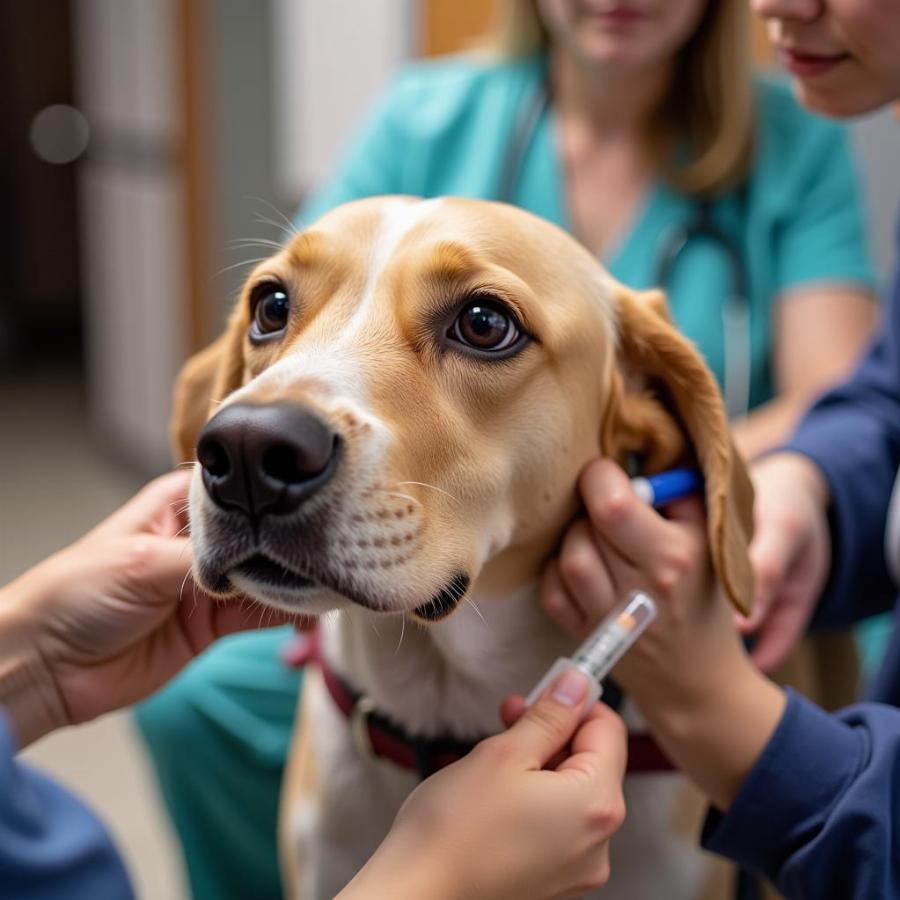EpiPens, or more accurately, epinephrine auto-injectors, are becoming increasingly recognized for their potential lifesaving role in canine emergencies. While traditionally associated with human allergic reactions, epinephrine can also be a critical tool in treating severe allergic reactions, or anaphylaxis, in dogs. Understanding when and how to use an EpiPen for your dog can be the difference between life and death in a crisis.
Understanding Anaphylaxis in Dogs
Anaphylaxis is a severe, potentially life-threatening allergic reaction. In dogs, it can be triggered by various allergens, including insect stings (bees, wasps, hornets), certain medications, and even some foods. The reaction manifests rapidly, often within minutes of exposure to the allergen. Symptoms can range from mild itching and hives to more severe signs like vomiting, diarrhea, facial swelling, difficulty breathing, and collapse.
Recognizing the Signs of Anaphylaxis
Knowing the signs of anaphylaxis is crucial for prompt action. If your dog experiences any of the following symptoms after exposure to a potential allergen, seek immediate veterinary attention:
- Facial Swelling: Noticeable swelling around the eyes, muzzle, and lips.
- Hives: Raised, itchy welts on the skin.
- Vomiting and Diarrhea: Often sudden and profuse.
- Difficulty Breathing: Rapid, shallow breathing, panting, or wheezing.
- Collapse and Loss of Consciousness: A sign of severe anaphylaxis.
When to Consider an Epipen for Your Dog
If your dog has a history of severe allergic reactions or is at high risk, your veterinarian may prescribe an epinephrine auto-injector. This isn’t a preventative measure but a crucial emergency tool to administer while rushing your dog to the vet. It buys precious time by temporarily counteracting the life-threatening effects of anaphylaxis.
Talking to Your Veterinarian About Epinephrine
Discuss your dog’s allergy history with your veterinarian. They can assess the risks and benefits of having an epinephrine auto-injector on hand. Remember, this is a prescription medication and requires proper training on dosage and administration from your vet. Never self-prescribe or administer epinephrine without professional guidance.
How to Administer an Epipen to a Dog
Administering an epinephrine auto-injector can be daunting, but in an emergency, it’s crucial to act swiftly and calmly. Your veterinarian will demonstrate the proper technique, which typically involves injecting the epinephrine into the dog’s thigh muscle.
Steps for Epinephrine Administration:
- Remove the safety cap.
- Position the injector against the dog’s outer thigh, perpendicular to the skin.
- Press firmly and hold for a few seconds to ensure the full dose is injected.
After Administering Epinephrine
Even after administering epinephrine, immediately transport your dog to the nearest veterinary clinic. Epinephrine provides temporary relief, not a cure. Your dog will need further evaluation and treatment to manage the underlying allergic reaction.
Monitoring Your Dog Post-Injection
While en route to the vet, observe your dog for any changes in their condition. Note any improvement or worsening of symptoms, and relay this information to the veterinary team upon arrival.
 Dog at vet after EpiPen administration
Dog at vet after EpiPen administration
Conclusion
An epipen for dogs can be a valuable tool in managing severe allergic reactions. Understanding the signs of anaphylaxis, knowing when to administer epinephrine, and seeking immediate veterinary care are vital steps in ensuring your furry friend’s safety. Talk to your veterinarian today to discuss whether an epinephrine auto-injector is appropriate for your dog’s specific needs.
FAQs
- Can I use a human EpiPen on my dog? While theoretically possible, it’s crucial to consult your veterinarian for proper dosage and instructions.
- What are the side effects of epinephrine in dogs? Common side effects include increased heart rate, restlessness, and pale gums.
- How long does epinephrine last in dogs? The effects are typically short-lived, lasting anywhere from 15 minutes to a few hours.
- Where should I store my dog’s EpiPen? Store it in a cool, dry place, away from direct sunlight and out of reach of children.
- Can all dogs have an EpiPen? No. Some underlying health conditions may preclude its use. Consult your vet.
- How do I know if my dog needs an EpiPen? Discuss your dog’s allergy history with your veterinarian to assess the risk.
- What triggers allergic reactions in dogs? Common triggers include insect stings, certain medications, and certain foods.
Explore More at Beaut Dogs
- Learn more about Canine Allergies
- Explore different Dog First Aid Techniques
Beaut Dogs is your trusted source for all things canine, providing comprehensive and expert advice on dog care. From breed information to health and nutrition, we’re here to help you navigate the world of dog ownership. For personalized support and answers to your specific questions, please reach out to us at [email protected]. We’re dedicated to empowering dog lovers with the knowledge they need to provide the best possible care for their furry companions. Visit us at https://beautdogs.com to explore our resources and learn more.